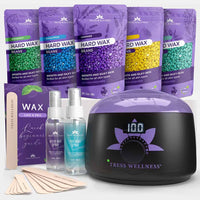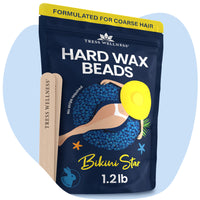Dealing with ingrown hair in pubic area? This article will guide you through effective treatment methods and practical prevention tips. Learn about common causes, symptoms, and when to seek medical advice regarding ingrown hair in pubic area.
Key Takeaways
-
Ingrown pubic hair occur when hair grows back improperly, often due to shaving or waxing, leading to bumps and inflammation.
-
Treatment options include warm compresses, exfoliation, and the use of sterile tools, while medications like steroid creams can help reduce inflammation.
-
Preventing ingrown hair involves proper shaving techniques, using single-bladed razors, and exploring alternative hair removal methods such as laser treatment.
What are Ingrown Pubic Hair?

Ingrown pubic hair are those that grow incorrectly and become trapped beneath the skin surface instead of emerging from the hair follicle. This can happen when the hair grows back into the skin rather than outward, leading to it becoming trapped. When a hair is trapped underneath the skin, it can cause inflammation and discomfort, resulting in small, often discolored bumps.
These ingrown hair bumps can be not only unsightly but also quite uncomfortable. The inflammation can cause redness and swelling, making the affected area sensitive to touch. Understanding what ingrown pubic hairs are is the first step in effectively treating and preventing them.
Causes of Ingrown Pubic Hair
Ingrown pubic hairs often arise when hair grows back incorrectly after removal methods like shaving, waxing, or plucking. The coarse and curly nature of pubic hair increases the likelihood of it curling back into the skin. Shaving in the opposite direction of hair growth can also increase the likelihood of ingrown hairs.
Improper hair removal techniques, such as plucking, can lead to ingrown hairs due to hairs breaking off inside or just outside the skin. This improper technique, combined with the use of dull razors, can exacerbate the chances of hair growing into the skin instead of outward. Additionally, friction from clothing or tight underwear can further irritate the skin and contribute to the formation of ingrown hairs.
Hair removal methods like waxing can cause hairs to grow inward if pulled improperly during waxing or if hair length is unsuitable. Understanding these causes can help you adopt better practices to prevent future ingrown hairs and maintain healthier skin.
Symptoms of Ingrown Pubic Hair

Common signs of ingrown pubic hair include lumpy areas and bumps that appear after shaving or waxing. These ingrown hair bumps typically appear as red, raised spots on the skin, sometimes with the hair trapped beneath the surface. The visible bumps can vary in color and may appear darker than the surrounding skin.
Symptoms of ingrown pubic hair can also include skin swelling and discoloration around the affected area. You might experience itchiness and, in some cases, pain. If the ingrown hair becomes infected, you may notice fluid or pus drainage, increasing pain, and severe swelling. Recognizing these symptoms early can help in addressing the issue promptly.
How to Treat Ingrown Pubic Hair
Most ingrown hairs can be managed effectively at home without professional intervention. Stop waxing, shaving, and tweezing if ingrown hairs cause severe irritation.
The following methods can help treat ingrown pubic hairs safely and effectively.
Warm Compresses
Applying a warm compress can help ease pain and draw out impurities from ingrown hairs. To do this, soak a clean cloth in warm water and apply it to the affected area for several minutes. This process reduces swelling and helps release ingrown hairs.
Consistent application of warm compresses can lead to quicker relief from ingrown hairs. Softening the skin and hair allows the trapped hair to emerge naturally, reducing discomfort and speeding up the healing process.
Exfoliation

Exfoliation helps hair return to the skin’s surface by removing dead skin cells that can trap hairs. Using products containing salicylic acid or glycolic acid can keep hair follicles open and prevent hairs from being trapped. Gently rub around the ingrown hair bumps with a wet washcloth or exfoliating glove in a circular motion to remove dead skin cells.
If you already have an ingrown hair, it’s best to avoid using exfoliating products. They may irritate the affected area. Regular exfoliation can prevent future ingrown hairs by keeping the skin clear and promoting natural hair growth.
Using Sterile Tools
Sterile tools help prevent infection and damage to the skin. A sterile needle can be used to expose the hair tip, which can then be gently pulled out with tweezers. Avoid plucking the hair out completely or digging into the skin, as this can cause further irritation.
Gently pulling out the hair loop without digging into the skin can help release the trapped hair. Always ensure that the tools are clean and sterile to minimize the risk of infection.
Medications and Creams for Ingrown Pubic Hair

Medications and creams can be effective in alleviating the symptoms of ingrown pubic hair and promoting healing. Over-the-counter options, such as steroid creams and retinoids, can reduce inflammation and redness associated with ingrown hairs.
The following sections detail the specific benefits and uses of these treatments.
Anti-Inflammatory Creams
Steroid creams are topical medications that help reduce inflammation and redness associated with various skin conditions, including ingrown hairs. Hydrocortisone cream is an affordable option that can alleviate itching and swelling.
Hydrocortisone cream can reduce symptoms of inflammation and irritation from ingrown hairs, making the area more comfortable. Apply a small amount to the affected area as directed to see the best results.
Retinoids
Retinoids are derived from Vitamin A. They assist in exfoliating skin cells and clearing dark patches. They are effective in speeding up the clearing of dead skin cells and improving skin appearance.
However, retinoids can cause dry skin and are not recommended for pregnant women due to the potential risk of developmental issues for the baby. A prescription is required to obtain retinoids.
Home Remedies for Ingrown Pubic Hair
Home remedies can effectively soothe and treat ingrown pubic hair, reducing irritation and promoting healing. A baking soda and oatmeal paste can soothe irritation and act as an exfoliant, helping to remove dead skin cells. A mixture of yogurt and oatmeal can reduce inflammation while gently exfoliating the skin.
Coconut oil mixed with sugar can create a hydrating scrub that reduces inflammation. A honey and oatmeal mixture can keep hair follicles clear and provide moisturizing benefits.
These natural remedies are gentle on the skin and can be used regularly to maintain healthy skin.
Prevention Tips for Ingrown Pubic Hair
Prevent ingrown pubic hair is essential because it helps avoid the discomfort and irritation they cause.
The following tips can help you minimize the risk of developing ingrown hairs and keep your skin smooth and healthy.
Proper Shaving Techniques
Preparing the pubic area for shaving includes cleaning and potentially trimming long hair to avoid tugging during shaving. Using a warm cloth or taking a warm shower helps expand the pores in the skin, making hair removal easier and reducing the risk of irritation.
Shaving gel creates a protective barrier, reducing friction and preventing irritation and cuts. Use light strokes when shaving and avoid pressing down too hard to prevent skin irritation. Always shave in the direction of hair growth to minimize chances of ingrown hairs and skin irritation.
Choosing the Right Razor

A single-bladed razor significantly reduces the risk of ingrown pubic hairs. Replace your razor blade every five to seven shaves to minimize the risk of ingrown hairs. A clean, sharp razor ensures a smoother shave and reduces the likelihood of hair growing back into the skin.
Investing in a good-quality razor and replacing the blades regularly can make a significant difference in preventing ingrown hairs.
Alternative Hair Removal Methods
Laser hair removal is an alternative method that can significantly reduce ingrown pubic hairs. It usually results in semi-permanent hair removal, although it is not as effective on lighter hair colors. Electrolysis involves destroying the hair root using an electrode and is performed by a licensed professional, providing a more permanent solution.
Chemical hair removers can be a less irritating alternative that leads to fewer ingrown hairs compared to shaving and waxing. These removers work by disrupting normal hair structure for easier removal. Additionally, trimming or lightening hair instead of removing it completely can also prevent ingrown hairs.
Non-razor hair removal options include chemical hair removers, laser hair removal, and electrolysis. Switching to waxing might help reduce ingrown hairs, especially with products like Bikini Star Beads, which are tough on coarse hair and gentle on the skin.
When to See a Healthcare Provider
If you notice any signs of infection or experience severe pain from an ingrown hair, it is important to visit a healthcare provider. Symptoms of infection from an infected ingrown pubic hair include painful, pus-filled bumps. Additionally, there may be darkening of the surrounding skin.
An infected ingrown hair may result in painful bumps and pus-filled blisters. Clean instruments can help minimize the risk of infection when extracting ingrown hairs, but consult a healthcare provider if symptoms worsen.
Summary
Managing and preventing ingrown pubic hairs involves a combination of proper hair removal techniques, effective treatments, and proactive prevention methods. Understanding the causes and symptoms of ingrown hairs allows you to address the issue promptly and effectively.
By following the tips and methods outlined in this guide, you can keep your skin smooth and healthy, free from the discomfort and irritation of ingrown hairs. Remember, taking care of your skin is an ongoing process, but with the right knowledge and tools, you can achieve the best results.
Frequently Asked Questions
What causes ingrown pubic hairs?
Ingrown pubic hairs are mainly caused by improper hair removal methods, friction, and the coarse texture of pubic hair. To avoid them, consider using gentle techniques and products designed for sensitive areas.
How can I prevent ingrown pubic hair?
To prevent ingrown pubic hair, use proper shaving techniques and the right razor, or consider alternatives like laser hair removal. It’s all about finding what works best for you!
What are the symptoms of ingrown pubic hair?
If you're dealing with ingrown pubic hair, you might notice red, raised bumps, itchiness, and some pain. In worse cases, you could even see pus-filled blisters indicating an infection.
Are there home remedies for treating ingrown pubic hairs?
Absolutely! A baking soda paste, a yogurt and oatmeal mixture, or a coconut oil scrub can effectively soothe and treat those pesky ingrown pubic hairs. Give them a try!
When should I see a healthcare provider for an ingrown pubic hair?
You should see a healthcare provider for an ingrown pubic hair if you notice signs of infection, like painful bumps filled with pus or if you're experiencing severe pain. Don’t hesitate to get it checked out!



